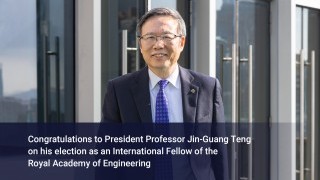Pioneering technologies to detect hidden water pipe leaks and underground voids
Hong Kong isn’t just crowded above ground; beneath the city lies a complex maze of utilities that makes maintaining vital infrastructure particularly challenging. To support sustainable urban development, PolyU researchers have developed innovative inspection systems using advanced underground exploration technologies. These systems can detect anomalies such as voids and water pipe leakages at an early stage, helping to prevent service disruptions and even road accidents.
Led by Professor Wallace Lai Wai-lok, Associate Head and Professor of the Department of Land Surveying and Geo-Informatics, the PolyU research team has harnessed advanced multi-channel and vehicle-towed ground-penetrating radar (GPR) technology to accurately locate the source and determine the severity of leaks by analysing underground images and leak noises, providing crucial information to identify and address potential problems before they escalate.
“Traditionally, GPR technology is used for subjective near-surface geophysical mapping and prospecting. Our research presents a significant advancement in using it as an objective measurement and a diagnostic tool to identify and locate hazards, and assess their severity, further advancing the application of GPR,” said Professor Lai.

Prof. Wallace Lai’s research team leveraged advanced underground exploration technologies to develop inspection systems that enable early detection of anomalies in urban infrastructure.
In addition to imaging, the team studies the sounds produced by leaking pipes. By analysing the characteristics of noises from different types of leaks – such as pipe cracks or valve leaks – they can pinpoint the exact location and nature of the problem. To further enhance precision, the team is exploring the use of robots equipped with acoustic hydrophones that travel inside pipes, collecting sound data directly for more accurate leak detection.
Looking ahead, the team is integrating artificial intelligence and robotics into their work. By building a comprehensive database of GPR images and leak noises, and developing AI models for analysis, they aim to make inspections faster and more reliable. They envision that this initiative will facilitate large-scale inspection of underground pipelines in Hong Kong and beyond.
Professor Lai’s projects have received strong support from government and industrial partners. Notably, the Water Supplies Department (WSD) collaborated with his team to launch the Q-Leak underground water mains leak detection training centre in 2021, advancing leak detection technology. Recently, PolyU and WSD signed a Memorandum of Understanding with Shenzhen Bwell Technology Co. Ltd to establish the Pipeline Robots Joint Laboratory, focusing on developing advanced pipeline robotics technologies. Click here to learn more about this collaboration.






